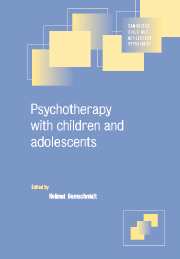Book contents
- Frontmatter
- Contents
- List of contributors
- Preface
- Part I Principles of psychotherapy with children, adolescents and families
- Part II Psychotherapeutic methods and settings
- Part III The practice of psychotherapy for specific disorders in childhood and adolescence
- 15 Anxiety disorders
- 16 Obsessive-compulsive disorder
- 17 Depressive syndromes and suicide
- 18 Dissociative [conversion] disorders
- 19 Disorders of sexual development and sexual behaviour
- 20 Substance abuse and addiction
- 21 Eating disorders
- 22 Psychotherapy in chronic physical disorders
- 23 Enuresis and faecal soiling
- 24 Dyslexia and dyscalculia
- 25 Stuttering
- 26 Hyperkinetic disorders
- 27 Autism
- 28 Schizophrenia
- 29 Conduct disorders, antisocial behaviour, delinquency
- 30 Physical abuse and neglect
- 31 Sexual abuse and sexual maltreatment
- Part IV The practice of psychotherapy in various settings
- Index
19 - Disorders of sexual development and sexual behaviour
- Frontmatter
- Contents
- List of contributors
- Preface
- Part I Principles of psychotherapy with children, adolescents and families
- Part II Psychotherapeutic methods and settings
- Part III The practice of psychotherapy for specific disorders in childhood and adolescence
- 15 Anxiety disorders
- 16 Obsessive-compulsive disorder
- 17 Depressive syndromes and suicide
- 18 Dissociative [conversion] disorders
- 19 Disorders of sexual development and sexual behaviour
- 20 Substance abuse and addiction
- 21 Eating disorders
- 22 Psychotherapy in chronic physical disorders
- 23 Enuresis and faecal soiling
- 24 Dyslexia and dyscalculia
- 25 Stuttering
- 26 Hyperkinetic disorders
- 27 Autism
- 28 Schizophrenia
- 29 Conduct disorders, antisocial behaviour, delinquency
- 30 Physical abuse and neglect
- 31 Sexual abuse and sexual maltreatment
- Part IV The practice of psychotherapy in various settings
- Index
Summary
Characteristics of the disorders and classification
In assessing sexual abnormalities in childhood and adolescence, four aspects should be observed:
specific phase-related aspects of biological development,
timing and contents of sexual education and the development of gender specific behaviour,
the present abnormal situation, including possible ‘triggers’,
the psychosexual situation, including mental or physical disorders and the assessment for premature or protracted sexual development.
Normal variants of sexual behaviour
Masturbation
Definition
Intentional self-arousal by manual stimulation of the genitals with the aim of achieving sexual gratification is called masturbation (synonym: onanism). Masturbation is a common expression of human sexuality and is a normal phenomenon in the course of adolescence. However, excessive masturbation may require treatment. For retarded children, excessive masturbation may be a way of achieving substitute gratification and may require treatment if it is performed excessively and without regard for other individuals.
Under adverse conditions, masturbation may be associated with psychiatric symptoms in adolescence, e.g. by inappropriate sexual education, excessively religious upbringing (where masturbation is considered ‘sinful’), etc. The adolescent may experience feelings of guilt, which encourage the development of hypochondriasis with physical symptoms. Even paranoid symptoms may subsequently develop. Feelings of guilt are often accompanied by concern about the possibility of being sexually deviant. These adolescents tend to be inhibited in their contacts with peers. The combination of these two aspects may lead the adolescent to believe that he is sexually deviant and incapable of maintaining a normal sexual relationship, thus exacerbating his withdrawal.
- Type
- Chapter
- Information
- Psychotherapy with Children and Adolescents , pp. 315 - 326Publisher: Cambridge University PressPrint publication year: 2001



